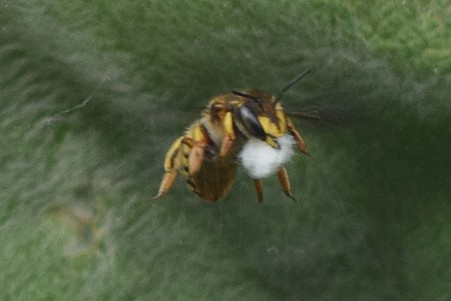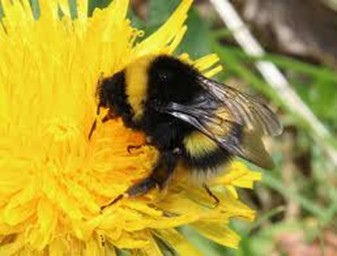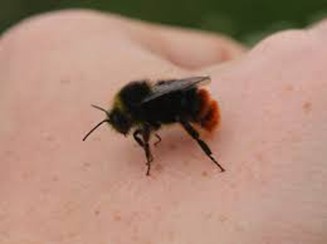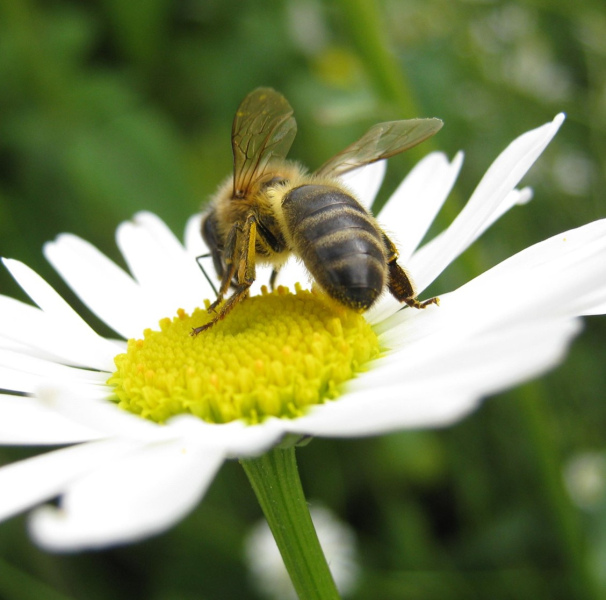Have you ever wondered where bees have come from? As a beekeeper I never cease to be amazed by these wonderful hardworking creatures and I had to find out about their origins. It’s a story that dates back millions of years to a time when flowering plants had yet to emerge and the earth looked very different than it does today. Green and brown foliage dominated, the main plants being ferns and conifer type trees. At this time there were Hunter wasps, these wasps were solitary in nature and they would build their nests in the ground or river banks. They collected prey, spiders and other insects, which they paralysed with their stinger and venom and brought back to their nest as food for their offspring. They were meat-eaters. There was no hands-on rearing of the offspring and no cooperation with other wasps. These solitary wasps were the ancestors of the bees we know and love today. Now as we know bees do not eat meat, they get all their food from plants, nectar provides carbohydrates and pollen provides protein, minerals and fats. So why did bees evolve from wasps? Well, the answer is flowering plants.
Pollination is sex for plants. Pollination enables fertilisation and all life strives to reproduce. For plants, stuck in one place, pollination was difficult and most plants of the time used wind to move pollen containing the male genetics to the female part of another plant of the same species. Wind pollination is very wasteful with up to 99% of the pollen lost. Nature had to come up with a better way. Around 130 million years ago flowering plants began to evolve. Pollen is very nutritious and the first pollination by insects probably took place by accident. Insects hungry struggling to find food may have turned to eating pollen in desperation and feeding it to their young. As they moved from plant to plant some of the pollen stuck to their body, landing on another plant's correct part. Pollination would have happened accidentally. Now nature had come up with a much more efficient way of transferring pollen between plants and it wasn’t about to miss its chance. Flowers began to develop petals, colors, shapes all to attract insects away from other plants in a massive advertising campaign that changed the world forever. Some plants even began to produce nectar, a sugary solution, as a reward for the insects that helped with pollination. The insects developed long tongues, hairy bodies and even pollen baskets. A mutualistic relationship developed between flowering plants and insects. The most successful to emerge were the bees. Plants provide all their dietary needs in return for all their hard work. Today there are over 400 thousand species of flowering plants on the planet making up around 80% of all plant life.
While the wasps continued on their evolutionary journey and there are hunter wasps all over the world today including Ireland, the bees branched off on their own evolutionary journey. The first bees to develop were solitary in nature with a lifecycle very closely related to their wasp relatives. The main difference being diet and the evolution of their bodies to enhance their pollination effectiveness. Put simply, the definition of a bee is “with branched hairs”. Bees have plumose hairs on their bodies to easily trap pollen and transport to other flowers for pollination. Wasps have smooth bodies and while they do pollinate, they are said to be accidental pollinators. There are 77 species of solitary bee in Ireland. They do not produce honey, have a queen or live in hives. The males and females emerge and mate, the females lay eggs an provide for their offspring but again there is no hands-on rearing. The offspring cocoon over winter until it’s time to emerge and begin the lifecycle over again. They are very specialized in the type of flowers they forage and this dictates the time of year each species is active. The Wool Carder bee is active from June to August and prefers plants like lambs’ ear, mint and sage. Plants with hairs on their stems which she strips away and take back to use as nesting material.

Female wool carder bee
These bees are small in nature with a stinger that has little to no effect on humans, only live for around 8 to 10 weeks and generally go unnoticed in our gardens. The All-Ireland Pollinator Plan website is a great resource for helping you identify these fantastic and very diverse bees.
Bumble Bees evolved sometime between 25 and 40 million years ago. Most likely evolved in central Asia, during a cooling of the earth’s temperature. They have a very different life cycle to their solitary ancestors. Bumblebee colonies are headed by a Queen and all the other female bees give up their right to reproduce to pass on their genetics through their mother. The queen emerges in the spring from winter hibernation and has to find a nest site, make it comfortable, and forage for food. She then lays eggs and has to incubate them, only when her first batch of brood emerges into adult bees can she sit back as they then take over the duties of foraging and caring for her and any future brood. The queen at this stage just has to lay eggs. All brood raised at this stage are female or workers but late in the summer, the queen will lay males (drones) and then virgin queens who will be the queens for the following year. The virgin queens go out and get mated and feed themselves up ready to hibernate for the winter. The rest of the colony will die off including the old queen. Only newly mated queens will make it to hibernation and then hopefully emerge the following spring to begin the life cycle once again. Bumble bees don’t make honey, they store nectar in the hive and usually have enough for about three days. They have a limited ability to control hive temperature and a loose social structure and basic communication. There are 21 species native to Ireland, 4 of which are endangered.

White Tailed Bumble Bee

Red Tailed Bumble Bee
Modern honeybees evolved around 22 to 25 million years ago. They evolved most likely in Central Asia from a strain of solitary bees. There are 9 species worldwide and only one is native to Ireland Apis Mellifera Mellifera or the Black Irish Bee. It is a subspecies of the Western Honeybee found in North Africa and most of Europe. Two things enabled the honeybee to spread over most of the planet. They ability to store food and the ability to control nest temperature. These play a crucial role in their survival today and helped them become the most important pollinator on the planet. The ability to store food enabled them to survive times when food is not readily available such as winter, a wet season or a dry season. The ability to control nest temperature i.e. cool it down in warmer climates or keep it warm in colder climates enables them to survive as a colony all year round, so they can rapidly build up numbers in the spring to take full advantage of the abundant spring nectar and pollen available. Colonies can have somewhere from 35,000-60,000 bees at their peak, with a very high degree of complex communication and clear social structure. Queens can live up to 5 years and colonies reproduce by swarming. When it’s time to reproduce the old queen will lay in special queen cells and these will produce virgin queens. One the first of these queen cells is capped over for the bee to pupate the old queen and half the bees will leave (swarm) and find a new location to start a colony. Meanwhile one of the virgin queens that emerge will take over as the new queen in the old colony. Honeybees make honey from nectar. Nectar can be up to 90% water; the bees have to evaporate the water content to below 20% so they can store it as honey. If the water content is higher than 20% then it will more than likely ferment and spoil. To eat the honey the bees must add water and dilute it to around 50% water, so who taught them to store it safely below 20% water content? Just one of the mysteries surrounding these wonderful creatures.

Irish Dark Bee
